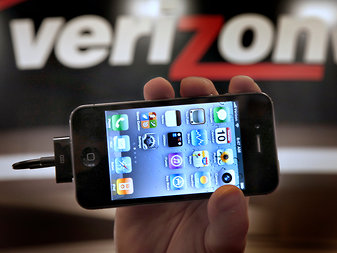 Amy Sancetta/Associated Press
Amy Sancetta/Associated Press
4:54 p.m. | Updated Adding commentary from a consumer-rights advocacy group and an analyst.
4:02 p.m. | Updated Removing commentary from an analyst who called this a price hike. Verizon has clarified that customers on its current tiered data plans can stay on them.
In a first for the American wireless industry, Verizon Wireless said on Tuesday that it was introducing plans that would allow customers to pay for a certain amount of wireless data and share that allotment across their family’s smartphones, tablets and laptops.
To Verizon, this is an evolution of family plans for cellphones, which offer a shared pool of calling minutes and text messages. The new plans include unlimited calls and texts, but they put limits on wireless data — at a time when mobile Internet use is cutting down on time spent talking and texting.
The shared plans could help Verizon offset the decline in revenue that the trend is causing. Verizon is not the only carrier that recognizes this: ATT, the second-biggest American carrier after Verizon, has also said that it plans to introduce shared plans this year.
Consumers may find the new plans more appealing than having to get separate data contracts for, say, an iPad and a teenager’s phone. But the idea of paying for unlimited texts and calls may not sit well with everyone.
“Verizon is finally delivering something that everybody wants — in a way that nobody wants,” said Jan Dawson, a mobile analyst at Ovum, a research firm. “There are people who want a shared data plan and minimal voice and text messages, and that just isn’t available.”
For Verizon customers, the shared plans are an option, not a replacement for their current phone plans, which involve paying a monthly fee for a certain amount of minutes, text messages and data.
Brenda Raney, a Verizon spokeswoman, said customers with these older plans would not be required to switch to a shared plan, even when they upgraded to a new device.
“The point of this is customer flexibility and value,” Ms. Raney said. “If you have a smartphone and you don’t have a tablet, but you’re at the beach one day and your friend has a tablet, you can activate it right then and there because it’s included in the data plan.”
The shared plans may have repercussions for customers who are clinging to unlimited data plans. Verizon discontinued these last year, but customers who wanted to keep them were allowed to do so. After the shared plans come into effect later this month, Verizon’s unlimited data customers who want to get a new phone at a discounted price will have to pick either a limited data plan or a shared plan. They can keep their old plans only if they buy a new smartphone at its full, unsubsidized price — often hundreds of dollars.
Customers who choose a shared data plan will pay a monthly fee for each device on their account. A smartphone would cost $40 a month, a normal cellphone $30 and a tablet $10. Then there is an additional monthly fee for the shared data pool, ranging from $50 for 1 gigabyte to $100 for 10 gigabytes. A family of three with an iPhone, a regular cellphone and an iPad that wants 10 gigabytes would pay a total of $180 a month.
When an account is close to using up its data, each device on the shared plan receives an alert asking if the customer wants to buy an extra 2 gigabytes of data for $10, Ms. Raney of Verizon said. But if they ignore this and go over the limit, they have to pay $15 for every extra gigabyte they use, she said.
Verizon previously outlined to investors how these plans would help it make more money. Francis J. Shammo, Verizon’s chief financial officer, said at a recent investors’ conference that the company believed that its faster fourth-generation LTE network would encourage people to stream video and generally be heavier users of data, eventually prompting them to buy the more expensive plans. He added that the new plans would help push the old unlimited customers off those plans.
“It is going to be more important that people will start to upgrade in their tiers as they start to really realize the benefits of the LTE network,” Mr. Shammo said. “Over the future time, as they add more devices, they are going to have to buy up into tiers.”
Michael Weinberg, senior staff lawyer at Public Knowledge, a consumer-rights advocacy group, said he was puzzled by one aspect of the new plans. He said he found it odd that customers had to pay an additional fee per device when they were already paying for the data they were using.
“I’m already cutting Verizon a check for a pool of data,” he said. “Why do I have to pay a monthly extra fee just for the pleasure of adding a device to my account?”
Article source: http://bits.blogs.nytimes.com/2012/06/12/verizon-shared-data-plans/?partner=rss&emc=rss